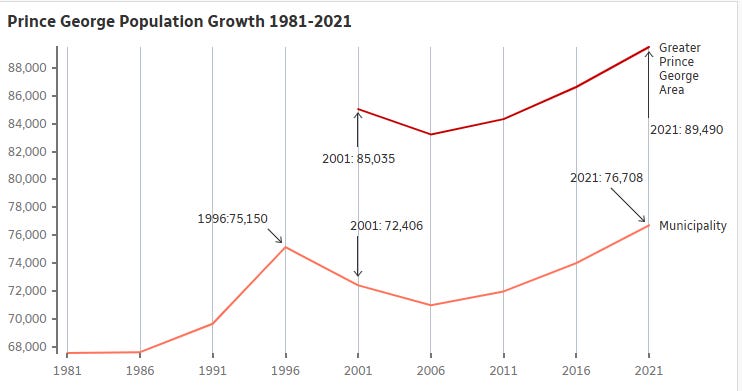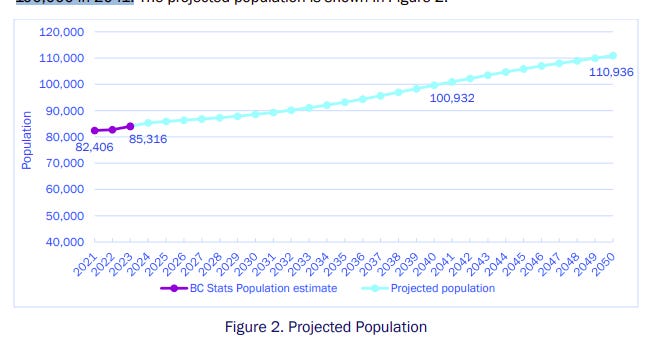Buried in my newsletter yesterday was the story from the Prince George Citizen that the new official community plan projects the city to reach 100,000 by 2040, which is just 15 years from now. Kathy made a comment that echoes something I’ve heard a lot from people when talking about the extra traffic, additional housing, etc we’ve seen, which is:
Our population hasn't grown in the 30 years I've lived here. So growing to 100,000 in 15 years? And then in the next link, that SD57 enrolment will drop? Something's not quite aligning.
So there’s a few thing here. First, let’s start with the persistent myth that Prince George’s population hasn’t increased in 30 years. 30 years ago it was 1995, which means Statistics Canada was gathering data to be released in its 1996 census profile. And that year it found the population of Prince George was 75,150. 15 years later the 2021 data came out - the most recent year available — and the population was.. 76,708. A net growth of 1,558. OK, that’s pretty small.
Except: That’s just 25 years, not 30 — we’ll have to wait for 2026 to get the real comparison. But also buried in there is the fact that 1996 was the peak population for the city before going into a decade-long downward dive which we started recovering from by 2011. Here’s a chart showing the trends (I put the “Greater Prince George” area on there just to take a look, but we’re really working with the municipal data):
And here it is, just written out:
1981: 67,559
1986: 67,621
1991: 69,653
1996: 75,150
2001: 72,406
2006: 70,981
2011: 71,974
2016: 74,003
2021: 76,708
So comparing 1996 to 2021 you see a net growth of 1,558. But compare 2021 to 1991 and you see a net growth of 7,055 — a ten per cent increase. But still, another ten per cent increase over the next 30 years and we’d be sitting at about 84,000 in 2051 — still a far cry from the 100,000 projection.
So where does that higher number come from?
Rather than StatsCan, the city is using B.C. Stats data which collects population counts yearly, rather than every five years, and is generally considered less “official” but more responsive to micro-trends. It also tends to have a higher population count compared to Stats Can — by way of comparison, in 2001 when Stats Can had us at 72,406, the B.C. Stats estimate was 75,417. For 2021 it was 80,251 compared by Stats Canada’s 76,708 and in 2023 that was 82,646.
Here’s where I get confused. In the city report, they write:
In 2024, the population of Prince George was estimated to be 85,316 (BC Stats Projected Populations). Using BC Stats Population Projections data, population growth in Prince George was projected to the year 2050. BC Stats population projections by age group (available up to the year 2046) were extrapolated to 2050, then combined to find the total projected population count.
Based on this projection, the population of Prince George is expected to increase by 25,620 people (30 percent), from 85,316 people in 2024 to 110,936 people in 2050, surpassing 100,000 in 2041.
However, when I look, the province’s population estimate for 2024 is 85,044 and the 2046 projection is 94,216. I am thinking the city must be looking at a more update projection list than I am but I would also question why a mild difference in current population (just a couple hundred more people in the data I’m looking at very what the city report says) would result in the 2046 estimate I have being 6,000 people fewer than the 2041 estimate the city has.
EDIT - I found the source of the data, which is a more recent B.C. Stats report here. I am keeping the above, though, because it’s worth noting how different the projections are year-to-year.
Notably, the report above — all of this data, in fact — came in before the federal government announced plans to stablize immigration. And, like much of the country, our population growth recently — and projected — was largely driven by newcomers. In fact, Stats Canada has a report on that! This one is based on the greater Prince George area population in 2021, which was 89,490.
That report projects that without immigration, the region would see just a 0.4 per cent increase in population and a rapid aging up — with the proportion of seniors in the community increasing by 44 per cent, to the number of children in the city decreasing by 21 per cent.
All of which is to say, is Prince George likely to hit 100,000 by 2050? To do so would require a population increase akin to our boom years of the 50-70s and with immigration levels dramatically being cut, I wouldn’t necessarily count on it.
This does segue nicely, though into the second part of the question which is why, if our population is growing, are we seeing student enrolment numbers drop and the answer is we are an aging city. There are fewer young people living here, and of those who are, fewer are having kids than in the past. This also happens to be why even though the population hasn’t dramatically increased, housing demand has — more adults, fewer kids, means more housing units needed even if population isn’t growing by as much. So yeah. That’s a lot of math, for me.
News roundup:
I’m told there was one lone boo during the anthem at the Cougars games this weekend. And now we get a 30 day reprieve.
The city is reporting an increase of copper wire theft, costing $25,000 since October. Here’s a piece on why this problem is prevalent, growing, and tough to solve.
One person arrested after early-morning incident in the Hart that led to nearby evacuations.
Prince George council spent $22.5k in travel in last half of 2024.
Prince George and the north reach an electric vehicle milestone.
Evan Bichon blasts his way to top-11 finish at World Cup snowboard cross race in China.
Prince George has officially joined the Strong Cities Network. More on that here.
Northern Capital News is a free, daily newsletter about life in Prince George. Please consider subscribing or, if you have, sharing with someone else.
Send feedback by emailing northerncapitalnews@gmail.com. Find me online at akurjata.ca.







Looking at the BC Stats report and the one from the city, I don't see anything about the potential effects of local and regional resource extraction and processing. Maaaaaaybe BC Stats is accounting for this in the underlying data and not pointing it out? While PG's economic drivers have been steadily diversifying (education and healthcare have been growing sectors - you and Joel McKay wrote about it in a previous newsletter here https://akurjata.substack.com/p/it-will-take-years-to-measure-the) and we have limited capability to predict the political and economic landscape 25 years from now, I suspect we will be seeing massive changes to the resource industry up here, which will directly impact our population.
And to talk directly about the impacts the changing resource landscape is having on my household specifically: my husband worked at Northwood for the last 12 years - and by this time next week, Husband will be living in Edmonton, and starting a new job a week after that, because of the growing precariousness of the Canfor mills. I'm incredibly lucky to have a job that can be done remotely (and the support of my supervisor, boss, and union!) and will be joining him in a few months. We're grateful to be 'getting out' before another mill closure is announced, because that will increase the competition for jobs and potentially affect the housing market as people seek employment elsewhere. While the impact of this on PG is minuscule (we're just two people), we will no longer be spending our money in town, illustrating the downstream effects of population changes: contributions to the local economy such as eating out and supporting local businesses.
Anyway it's first thing in the morning and I'm rambling in my under-caffeinated state. Thank you thank you thank you for drawing attention to this and providing a comment section where us readers can have conversations (ngl - 4streegrrl, I'm looking forward to hearing your thoughts on this!)
I don't think 100k by 2050 is that unreasonable. Population forecasting is a bit of a dark art, but I think there is a tendency for forecasters to be rather conservative these days with their projections, versus some of the over-the-top projection that were made in the 1950's.